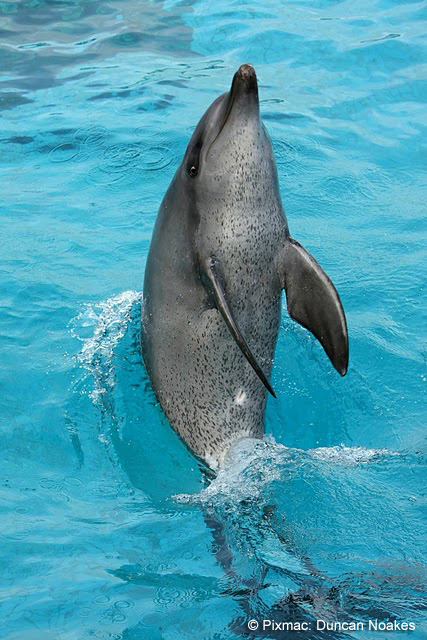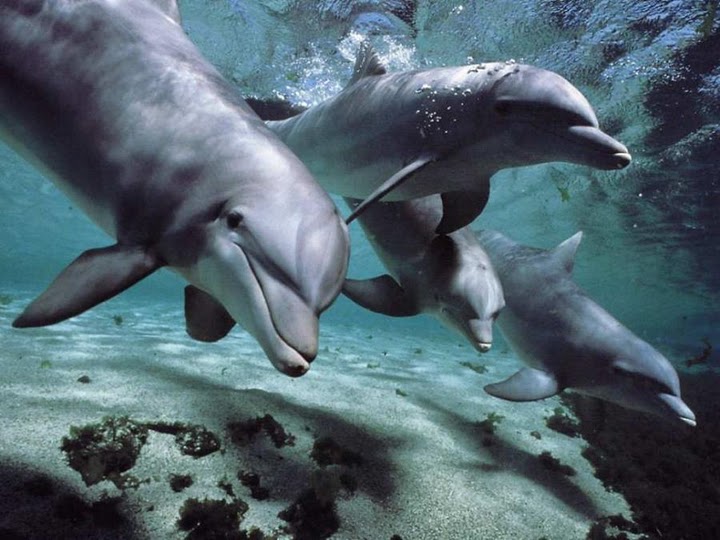Life and Culture in the Dolphin World
Dolphins and UsPart One: The Smartest of Us All? “So Long, and Thanks for All the Fish!” Amazing Abilities of Dolphins Dolphins or Humans: Who’s Smarter? Dolphin Society and Culture They’re Super-Brainy, Too More Fascinating Stuff The Great Researcher A Society that Works Are Dolphins “Persons” Life and Culture How Smart is a Dolphin? Experimenting on Dolphins My Visit to the Dolphins Other Links & Videos Mirror Self-Recognition Test The Herman Investigation The Minds of Whales |
Wildlife biologist Philippa Brakes, of the Whale & Dolphin Conservation Society, explains what we mean by dolphin culture – how dolphins live, what they teach their children and each other, their languages and dialects, their games and gatherings. And she also tells us the one thing she’d most like to ask dolphins.
Earth in Transition: What do you mean by culture? Is it like what we’ve heard about dolphins in Australia who have learned how to use sponges to protect their noses when they’re looking for something to eat along the bottom, and how they’ve passed that on to their children?
 Philippa Brakes: Yes, that’s exactly the kind of thing. Like the humpbacks and their songs. Or in sperm whales, where we’ve noticed that a particular behavior by males may make them more attractive to females to mate. So if you remove those males from the population, the actual population itself may be reduced.
Philippa Brakes: Yes, that’s exactly the kind of thing. Like the humpbacks and their songs. Or in sperm whales, where we’ve noticed that a particular behavior by males may make them more attractive to females to mate. So if you remove those males from the population, the actual population itself may be reduced.
What would be other examples of dolphin culture?
P.B. A colleague of mine noted that a dolphin who had been released from captivity in Australia and had watched other dolphins being trained to tail walk [while she was at the oceanarium], was teaching the other animals within her pod group to tail walk too. And those dolphins, who had been studied for a very long time, had never done any tail walking.
I know this would be very speculative, but can you imagine at all what is transpiring in their minds?
 P.B.: Well, as you say, that would be conjecture, but it could be any number of things. It could just be for fun. But then it could be that moving along with your tail is not the major part of it; it could be the large heavy slap down at the end of it, which could have something to do with attracting prey. So it’s difficult to know what’s going on there. But at a guess, I’d say that it looks like it’s probably fun, and it may be that they’re just doing it for fun.
P.B.: Well, as you say, that would be conjecture, but it could be any number of things. It could just be for fun. But then it could be that moving along with your tail is not the major part of it; it could be the large heavy slap down at the end of it, which could have something to do with attracting prey. So it’s difficult to know what’s going on there. But at a guess, I’d say that it looks like it’s probably fun, and it may be that they’re just doing it for fun.
We have to be careful not to try to see their world through our eyes. They have a very different way of perceiving the world in sensory terms. Our primary sense is vision. We take in a lot of information visually. Now dolphins don’t have terrible eyesight by any stretch, but their primary sense is sound. They can transmit sound, and they use sound to see almost. They can fire off intense sound beams that bounce back and tell them not only what the surface of something looks like, but what the actual texture looks like, what’s inside it. And they’re able to see what other dolphins can see — or rather hear. There’s been science that’s proven that they will eavesdrop on each other’s echo location signals. So there’s so very much about their world we don’t understand, that it sort of, once you start to open up the box, it’s a bit mind blowing.
Being a dolphin
So do you have any idea of what it might feel like to be a dolphin?
P.B.: There are lots of aspects of their lives that are very alien to us. The world they live in is watery. So they don’t the limitation of gravity that we have. And their primary sense is sound. They have tight-knit social groups. They’re very tactile with each other. They communicate not only through sound but through touch. It’s a totally difference existence.
And quite possibly it’s as intellectually profound as ours. Who are we to say just because they don’t have books or the Internet that their ability to communicate with each other about what’s going on around them isn’t also very well developed?
“They can tell not only what the surface of something looks like, but what’s inside it.
And they’re able to see what other dolphins can see — or rather hear.”
If we start to understand that dolphins and whales know something about what they understand about the world, that’s a very high level of cognition. And it makes you wonder what these animals are thinking when they’re kept in a tank for 20 years with none of their fellow beings around, and they have none of the environment that they would normally be playing in.
The kind of research that people do with captive dolphins seems to be much more about whether they can understand us and our language than how well we understand them? Like our language and our culture is the only thing that matters, and we judge them by whether they can understand us.
P.B.: Yes. There are some people definitely trying to study their clicks and whistles, but I think you’re right. I think that a lot of the way that we approach research is from a human-centric perspective of what can they understand about our world. I suppose we had to start from somewhere, but if we’re really going to unravel some of these incredible mysteries, then we do have to start thinking from their perspective.
Can we just get along?
You hear stories from time to time of dolphins helping people, like the famous story of a bunch of dolphins surrounding someone who was possibly going to be attacked by a shark. And it always leads me to wonder why they would be doing that. Why would they care about humans in the first place? I mean, it’s not as though we’ve helped them out and they feel a need to return the favor.
P.B.: Well, I guess, that is the $64,000 question? There are a lot of questions being raised at the moment about the morals of other species. We do know that they recognize when individuals within their group are unwell and a bit helpless. Certainly with calves, a mother will bring a calf to the surface to help it breathe and quite often, with an individual that’s not very well, certainly if it’s not able to reach the surface, others may bring it to the surface. So, it wouldn’t be beyond the realm of possibility that if they saw a human, and the human was clearly panicking and in some danger, then they could be responding as they do when they see one of their own species in danger. It’s a difficult question and it’s a really good one because some of the time that dolphins supposedly save humans, the humans actually don’t even know they’re in any danger until after the event. 
What else fascinates you about their world?
P.B.: I guess I’d go back to the issue of culture because it takes you to the wider level of what they are able to transmit to each other. Blue whales can transmit sound over thousands of kilometers. So, that makes the world a totally different place for them.
When we look at Planet Earth from space, we tend to say “Isn’t it beautiful, two thirds water, lots of land, and there’s the bit of land I recognize. There’s my home.” It’s totally different for a cetacean. If a dolphin or whale was able to view the world from the outside, they probably would not even recognize the land or have any interest in it at all. Their world is the water, like the underwater canyons where sperm whales can go and find the squids that they feed on. It’s so conceptually different from the way we view the world, that it’s very hard for us to get our heads around.
If there was one thing more than anything that you would like to know about dolphins and you were able to ask them, what would that be?
P.B.: Well, there are lots of things I’d like to know. I suppose the thing I think I’d like to know most, so that I could tell everybody, is what they think when they are caught up in one of those dreadful drive-hunts. If I could write that down and send it out to the newspapers as a direct quote from one of those animals, I think we would be able to end those hunts tomorrow.
~~~~~~~~~~~~~~~~~~~~~~~~~~~~
About Philippa Brakes and the Whale & Dolphin Conservation Society
Philippa runs the ethics and welfare program for the Whale & Dolphin Conservation Society. Much of her work involves studying what science tells us about these animals, what we’re beginning to learn about them and how that can then play out into making policy changes for them.
“Our focus,” she explained, “is very much on conservation. But we also run campaigns like against the drive hunts and the captivity of dolphins, and against whaling, which we’ve been battling for many years. We look at what is critical habitat for these animals and where do we need to protect areas where they may be breeding or feeding. We fund researchers all around the world, especially in developing countries who may not otherwise be able to find the funding. We had some people working in China on the ancient river dolphin. But, sadly, this animal has now been declared functionally extinct.
“And we like to fund researchers who have an interest in taking their research forward to make policy changes and management changes that will benefit these animals in the long term. So if they discover that there’s not very many of a particular species left that they will actually become advocates as well as researchers.”
